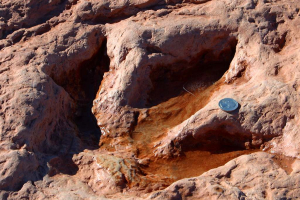Paleontologists have discovered what they believe is the largest dinosaur site in Scotland. Hundreds of dinosaur footprints are challenging the current theories about the lifestyle of these ancient creatures.
A team of university researchers found a large collection of footprints dating back to Jurassic Era. Some tracks reach 28 inches (70 cm) in diameter. Estimates show it was imprinted 170 million years ago by dinosaurs called sauropods.
Footprints are not the only interesting find of the researchers. The Isle of Skye in Scotland has remnants of Middle Jurassic era, which scientists considered as the most poorly understood time periods in dinosaur evolution. Only a few fossils were found from this age.
The recent findings "are extremely valuable for filling gaps in our understanding of dinosaur evolution," said Anthony Martin, a paleontologist from Emory University.
The researchers believe there are many sauropods living all around the lagoon millions of years ago. These dinosaurs were 50 (15 meters) long and weighed between 15 to 20 tons. It also four-legged herbivore with long tails and pillar-like legs.
Initial site investigations reveal there are 49 feet (15 meters) by 82 feet (25 meters) tracks all over the area.
The discovery of ancient habitat came as a surprise for researchers. They are still uncertain why these massive creatures prowled around the ancient Isle of Skye. Some experts believe lagoons and coasts have plenty of food and can serve as protection from predators.
In fact, the researchers found the site by chance. Heading back from a long day of fossil digging on the island's isolated far northeast, the team realized they had found something mysterious.
"As we were walking back to the cars, we noticed this big depression in the rock," team leader Steve Brusatte, a paleontologist from the University of Edinburgh, said in an interview with Fox News.
They considered themselves lucky to discover the ancient footprints. Before, researchers have only small number of bone and teeth fragments from sauropods.
By studying the footprints, the researchers believe the site is an ancient hangout of dinosaurs. The tracks also helped them to know the behavior of these behemoths.
"The reason why the site is so important is that these footprints were made in a lagoon. We know from the geology this was a lagoon," Brussate said.
They found sauropods preferred shallow waters. Maybe the dinosaurs waded through the water to cool themselves down.
The researchers hope there are still hidden ancient specimens from the Isle of Skye.
To know more about the latest findings, read the recent edition of Scottish Journal of Geology.
Dinosaurs thrived on Earth for more than 160 million years, from the Triassic period around 230 million years ago through the Jurassic period and until the end of the Cretaceous period around 65 million years ago.
Several studies proved that these massive creatures went extinction when a six-mile asteroid hit the Earth millions of years ago. The impact caused huge volcanic activities and powerful earthquakes.

















